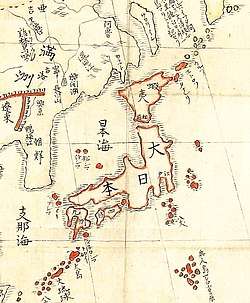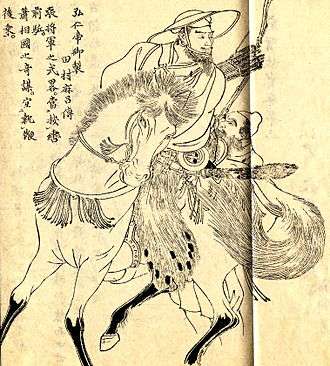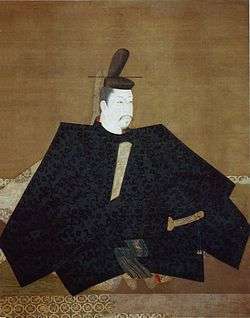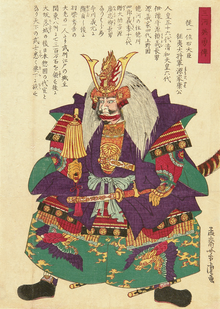Shogun
Shogun (将軍, shōgun, Japanese: [ɕoːɡɯɴ] (![]()
| History of Japan |
|---|
 |
The shogun's officials were collectively referred to as the bakufu, or tent government; they were the ones who carried out the actual duties of administration, while the Imperial court retained only nominal authority.[4] The tent symbolized the shogun's role as the military's field commander, but also denoted that such an office was meant to be temporary. Nevertheless, the institution, known in English as the shogunate (English: /ˈʃoʊɡəneɪt/ SHOH-gə-nayt[1]), persisted for nearly 700 years, ending when Tokugawa Yoshinobu relinquished the office to Emperor Meiji in 1867 as part of the Meiji Restoration.[5]
Etymology

The term shogun (将軍, lit. "army commander") is the abbreviation of the historical title "Seii Taishōgun." 征 (sei,せい) means "conquer" or "subjugate," and 夷 (i, い) means "barbarian" or "savage." 大 (dai, だい) means "great," 将 (shō, しょう) means "commander,"[6] and 軍 (gun, ぐん) means "army." [7] Thus, a literal translation of Seii Taishōgun would be "Commander-in-Chief of the Expeditionary Force Against the Barbarians."[3]
The term was originally used to refer to the general who commanded the army sent to fight the tribes of northern Japan, but after the twelfth century, the term was used to designate the leader of the samurai.[8]
Bakufu
The administration of a shogun is called bakufu (幕府) in Japanese and literally means "government from the maku (ja:幕)." During the battles, the head of the samurai army used to be sitting in a scissor chair inside a semi-open tent called maku that exhibited its respective mon or blazon. The application of the term bakufu to the shogun government shows an extremely strong and representative symbolism.[9]
Titles
Historically, similar terms to Seii Taishōgun were used with varying degrees of responsibility, although none of them had equal or more importance than Seii Taishōgun. Some of them were:
- Seitō Taishōgun (征東大将軍, lit. "Commander-in-chief for the pacification of the East") [10]
- Seisei Taishōgun (征西大将軍, lit. "Commander-in-chief for the pacification of the West") [11]
- Chinjufu Shōgun (鎮守府将軍, lit. "Commander-in-chief of the central peacekeeping headquarters") [12]
- Seiteki Taishōgun (征狄大将軍, lit. "Commander-in-chief Subjugator of the barbarians")
- Mochisetsu Taishōgun (持節大将軍, lit. "Commander-in-chief of the Temporary Office")
- Sekke shōgun (摂家将軍, lit. "Great General Counselor") [13]
- Miya shōgun (宮将軍, lit. "Great General of the Palace") [14]
- Mutsu Chintō Shōgun (陸奥鎮東将軍, lit. "Great General of Subduing Mutsu")
History
First shogun
There is no consensus among the various authors since some sources consider Tajihi no Agatamori the first, others say Ōtomo no Otomaro, other sources assure that the first was Sakanoue no Tamuramaro, while others avoid the problem by just mentioning from the first Kamakura shogun Minamoto no Yoritomo.
Heian period (794–1185)

Originally, the title of Sei-i Taishōgun ("Commander-in-Chief of the Expeditionary Force Against the Barbarians")[3] was given to military commanders during the early Heian period for the duration of military campaigns against the Emishi, who resisted the governance of the Kyoto-based imperial court. Ōtomo no Otomaro was the first Sei-i Taishōgun.[35] The most famous of these shoguns was Sakanoue no Tamuramaro.
In the later Heian period, one more shogun was appointed. Minamoto no Yoshinaka was named sei-i taishōgun during the Genpei War, only to be killed shortly thereafter by Minamoto no Yoshitsune.
Sakanoue no Tamuramaro
Sakanoue no Tamuramaro (758-811)[24] was a Japanese general who fought against the tribes of northern Japan (settled in the territory that today integrates the provinces of Mutsu and Dewa). Tamarumaro was the first general to bend these tribes, integrating its territory to that of the Japanese State. For his military feats he was named Seii Taishōgun and probably because he was the first to win the victory against the northern tribes he is generally recognized as the first shogun in history.[24][36][37] (Note: according to historical sources Ōtomo no Otomaro also had the title of Seii Taishōgun).
Kamakura shogunate (1192–1333)

In the early 11th century, daimyō protected by samurai came to dominate internal Japanese politics.[38] Two of the most powerful families – the Taira and Minamoto – fought for control over the declining imperial court. The Taira family seized control from 1160 to 1185, but was defeated by the Minamoto in the Battle of Dan-no-ura. Minamoto no Yoritomo seized power from the central government and aristocracy and established a feudal system based in Kamakura in which the private military, the samurai, gained some political powers while the Emperor and the aristocracy remained the de jure rulers. In 1192, Yoritomo was awarded the title of Sei-i Taishōgun by Emperor Go-Toba and the political system he developed with a succession of shoguns as the head became known as a shogunate. Yoritomo's wife's family, the Hōjō, seized power from the Kamakura shoguns.[39] When Yoritomo's sons and heirs were assassinated, the shogun himself became a hereditary figurehead. Real power rested with the Hōjō regents. The Kamakura shogunate lasted for almost 150 years, from 1192 to 1333.
The end of the Kamakura shogunate came when Kamakura fell in 1333, and the Hōjō Regency was destroyed. Two imperial families – the senior Northern Court and the junior Southern Court – had a claim to the throne. The problem was solved with the intercession of the Kamakura shogunate, who had the two lines alternate. This lasted until 1331, when Emperor Go-Daigo (of the Southern Court) tried to overthrow the shogunate to stop the alternation. As a result, Daigo was exiled. Around 1334–1336, Ashikaga Takauji helped Daigo regain his throne.[40]
The fight against the shogunate left the Emperor with too many people claiming a limited supply of land. Takauji turned against the Emperor when the discontent about the distribution of land grew great enough. In 1336 Daigo was banished again, in favor of a new Emperor.[40]
During the Kenmu Restoration, after the fall of the Kamakura shogunate in 1333, another short-lived shogun arose. Prince Moriyoshi (Morinaga), son of Go-Daigo, was awarded the title of Sei-i Taishōgun. However, Prince Moriyoshi was later put under house arrest and, in 1335, killed by Ashikaga Tadayoshi.
Ashikaga shogunate (1336–1573)
In 1338, Ashikaga Takauji, like Minamoto no Yoritomo, a descendant of the Minamoto princes, was awarded the title of sei-i taishōgun and established the Ashikaga shogunate, which nominally lasted until 1573. The Ashikaga had their headquarters in the Muromachi district of Kyoto, and the time during which they ruled is also known as the Muromachi period.
Azuchi–Momoyama period (1573–1600)
While the title of shogun went into abeyance due to technical reasons, Oda Nobunaga and his successor, Toyotomi Hideyoshi, who later obtained the position of Imperial Regent, gained far greater power than any of their predecessors had. Hideyoshi is considered by many historians to be among Japan's greatest rulers.
Tokugawa shogunate (1600–1868)

Tokugawa Ieyasu seized power and established a government at Edo (now known as Tokyo) in 1600. He received the title sei-i taishōgun in 1603, after he forged a family tree to show he was of Minamoto descent.[41] The Tokugawa shogunate lasted until 1867, when Tokugawa Yoshinobu resigned as shogun and abdicated his authority to Emperor Meiji.[42] Ieyasu set a precedent in 1605 when he retired as shogun in favour of his son Tokugawa Hidetada, though he maintained power from behind the scenes as Ōgosho (大御所, cloistered shogun).[43]
During the Edo period, effective power rested with the Tokugawa shogun, not the Emperor in Kyoto, even though the former ostensibly owed his position to the latter. The shogun controlled foreign policy, the military, and feudal patronage. The role of the Emperor was ceremonial, similar to the position of the Japanese monarchy after the Second World War.[44]
Timelines
Timeline of the Kamakura shogunate

Timeline of the Ashikaga shogunate

Timeline of the Tokugawa shogunate

Shogunate
The term bakufu (幕府, "tent government") originally meant the dwelling and household of a shogun, but in time, became a metonym for the system of government of a feudal military dictatorship, exercised in the name of the shogun or by the shogun himself. Therefore, various bakufu held absolute power over the country (territory ruled at that time) without pause from 1192 to 1867, glossing over actual power, clan and title transfers.
The shogunate system was originally established under the Kamakura shogunate by Minamoto no Yoritomo. Although theoretically, the state (and therefore the Emperor) held ownership of all land in Japan. The system had some feudal elements, with lesser territorial lords pledging their allegiance to greater ones. Samurai were rewarded for their loyalty with agricultural surplus, usually rice, or labor services from peasants. In contrast to European feudal knights, samurai were not landowners.[45] The hierarchy that held this system of government together was reinforced by close ties of loyalty between the daimyōs, samurai and their subordinates.
Each shogunate was dynamic, not static. Power was constantly shifting and authority was often ambiguous. The study of the ebbs and flows in this complex history continues to occupy the attention of scholars. Each shogunate encountered competition. Sources of competition included the Emperor and the court aristocracy, the remnants of the imperial governmental systems, the daimyōs, the shōen system, the great temples and shrines, the sōhei, the shugo and jitō, the jizamurai and early modern daimyō. Each shogunate reflected the necessity of new ways of balancing the changing requirements of central and regional authorities.[46]
Relationship with the emperor

Since Minamoto no Yoritomo turned the figure of the shogun into a permanent and hereditary position and until the Meiji Restoration there were two ruling classes in Japan: 1. the emperor or tennō (天皇, lit. "Heavenly Sovereign"),[47] who acted as "chief priest" of the official religion of the country, Shinto, and 2. the shogun, head of the army who also enjoyed civil, military, diplomatic and judicial authority.[48] Although in theory the shogun was an emperor's servant, it became the true power behind the throne.[49]
No shogun tried to usurp the throne, even when they had at their disposal the military power of the territory. There were two reasons primarily:[50]
- Theoretically the shogun received the power of the emperor, so this was his symbol of authority.
- There was a sentimentalist tradition created by priests and religious who traced the imperial line from the "age of the gods" into an "eternal line unbroken by the times." According to Japanese mythology, the emperor was a direct descendant of Amaterasu, goddess of the sun.
Unable to usurp the throne, the shoguns sought throughout history to keep the emperor away from the country's political activity, relegating them from the sphere of influence. One of the few powers that the imperial house could retain was that of being able to "control time" through the designation of the Japanese Nengō or Eras and the issuance of calendars.[51]
This is a highlight of two historical attempts of the emperor to recover the power they enjoyed before the establishment of the shogunate. In 1219 the Emperor Go-Toba accused the Hōjō as outlaws. Imperial troops mobilized, leading to the Jōkyū War (1219-1221), which would culminate in the third Battle of Uji (1221). During this, the imperial troops were defeated and the emperor Go-Toba was exiled.[52] With the defeat of Go-Toba, the samurai government over the country was confirmed.[52] At the beginning of the fourteenth century the Emperor Go-Daigo decided to rebel, but the Hōjō, who were then regents, sent an army from Kamakura. The emperor fled before the troops arrived and took the imperial insignia.[53] The shogun named his own emperor, giving rise to the era Nanboku-chō period (南北朝, lit. "Southern and Northern Courts").
During the 1850s and 1860s, the shogunate was severely pressured both abroad and by foreign powers. It was then that various groups angry with the shogunate for the concessions made to the various European countries found in the figure of the emperor an ally through which they could expel the Tokugawa shogunate from power. The motto of this movement was Sonnō jōi (尊王攘夷, "Revere the Emperor, Eject the Barbarians") and they finally succeeded in 1868, when imperial power was restored after centuries of being in the shadow of the country's political life.[54]
Legacy
Upon Japan's surrender after World War II, American Army General Douglas MacArthur became Japan's de facto ruler during the years of occupation. So great was his influence in Japan that he has been dubbed the Gaijin Shōgun (外人将軍).[55]
Today, the head of the Japanese government is the Prime Minister; the usage of the term "shogun" has nevertheless continued in colloquialisms. A retired Prime Minister who still wields considerable power and influence behind the scenes is called a "shadow shogun" (闇将軍, yami shōgun),[56] a sort of modern incarnation of the cloistered rule. Examples of "shadow shoguns" are former Prime Minister Kakuei Tanaka and the politician Ichirō Ozawa.[57]
See also
- Feudalism
- Kantō kubō
- History of Japan
- List of shoguns
References
- Wells, John (3 April 2008). Longman Pronunciation Dictionary (3rd ed.). Pearson Longman. ISBN 978-1-4058-8118-0.
- "Shogun". Encyclopædia Britannica. Retrieved November 19, 2014.
- The Modern Reader's Japanese-English Character Dictionary, ISBN 0-8048-0408-7
- Beasley, William G. (1955). Select Documents on Japanese Foreign Policy, 1853–1868, p. 321.
- Totman, Conrad (1966). "Political Succession in The Tokugawa Bakufu: Abe Masahiro's Rise to Power, 1843–1845". Harvard Journal of Asiatic Studies. 26: 102–124. doi:10.2307/2718461. JSTOR 2718461.
- "Yamasa Online Kanji Dictionary". Archived from the original on 15 April 2009. Retrieved 20 January 2009.
- "Yamasa Online Kanji Dictionary". Archived from the original on 1 February 2009. Retrieved 20 January 2009.
- Turnbull, 2006a:21 & 22.
- Turnbull, 2006a:207.
- Friday, 2007:108.
- Hall, 1991:241.
- Adolphson, 2007:341.
- Ishii, 2002:2396.
- Ishii, 2002:2467.
- There is no consensus among the various authors on this list since some sources consider Tajihi no Agatamori the first, some others take Ōtomo no Otomaro, other sources assure that the first was Sakanoue no Tamuramaro, while others avoid the problem by just mentioning from the first Kamakura shogun.
- Cranston, 1998:361.
- Samurai Archives. "Early Japan". Retrieved 20 January 2009.
- Cranston, 1998:427.
- Sansom, 1931:201.
- Takekoshi, 2004:96.
- Cambridge University Press. "Cambridge Histories Online". Retrieved 20 January 2009.
- Caiger, 1997:339.
- Shively, 1999:xviii.
- De Bary et al., 2001:266.
- The history files. "Shoguns of Japan". Retrieved 20 January 2009.
- Shively et al., 1999:30.
- Adolphson et al, 2007:334.
- Turnbull, 2005:16.
- Deal, 2007:100-101.
- Perkins, 1998b:292.
- Varley, 1994:243.
- Perkins, 1998b:295.
- Murdoch, 1996:791.
- Deal, 2007:48.
- 征夷大将軍―もう一つの国家主権 (in Japanese). Books Kinokuniya. Retrieved March 7, 2011.
- Andressen & Osborne, 2002:48.
- Ramirez-faria, 283.
- "Shogun". The World Book Encyclopedia. 17. World Book. 1992. pp. 432–433. ISBN 0-7166-0092-7.
- "shogun | Japanese title". Encyclopedia Britannica. Retrieved 2017-08-21.
- Sansom, George (1961). A History of Japan, 1134–1615. United States: Stanford University Press.
- Titsingh, I. (1834). Annales des empereurs du Japon, p. 409.
- "Japan". The World Book Encyclopedia. World Book. 1992. pp. 34–59. ISBN 0-7166-0092-7.
- Nussbaum, "Ogosho" at p. 738.
- Wakabayashi, Bob Tadashi (Winter 1991). "In Name Only: Imperial Sovereignty in Early Modern Japan". Journal of Japanese Studies. 17 (1): 25–57. doi:10.2307/132906. JSTOR 132906.
- Bentley, Jerry. Traditions and Encounters. pp. 301–302. ISBN 978-0-07-325230-8.
- Mass, J. et al., eds. (1985). The Bakufu in Japanese History, p. 189.
- Mitchelhill & Green, 2003:59.
- Kuno, 2007:245.
- Davis, 2001:205.
- Roth, 2007:103.
- Fiévé & Waley, 2003:235.
- Turnbull, 2006a:41.
- Turnbull, 2006a:43.
- Fiévé & Waley, 2003:236.
- Valley, David J. (April 15, 2000). Gaijin Shogun : Gen. Douglas MacArthur Stepfather of Postwar Japan. Title: Sektor Company. ISBN 978-0967817521. Retrieved 2 June 2017.
- "闇将軍". Kotobank.
- Ichiro Ozawa: the shadow shogun. In: The Economist, September 10, 2009.
Bibliography
- Adolphson, Mikael; Edward Kamens, Stacie Matsumoto (2007). Heian Japan: Centers and Peripheries. University of Hawaii Press. ISBN 0-8248-3013-X.
- Friday, Karl (2007). The First Samurai: The Life and Legend of the Warrior Rebel, Taira Masakado. John Wiley and Sons. ISBN 0-471-76082-X.
- Hall, John Whitney; James L. McClain, Marius B. Jansen (1991). The Cambridge History of Japan. Cambridge University Press. ISBN 0-521-22355-5.
- Iwao, Seiichi; Teizō Iyanaga, Maison franco-japonaise Tōkyō, Susumu Ishii, Shōichirō Yoshida (2002). Maisonneuve & Larose. ISBN 2-7068-1575-2.
- Cranston, Edwin (1998). A Waka Anthology: Volume One: The Gem-Glistening Cup. Stanford University Press. ISBN 0-8047-3157-8.
- Sansom, George Bailey (1931). Japan: A Short Cultural History. Stanford University Pres. ISBN 0-8047-0954-8.
- Takekoshi, Yosaburō (2004). The Economic Aspects of the History of the Civilization of Japan. Taylor & Francis. ISBN 0-415-32379-7.
- Shively, Donald; John Whitney Hall, William H. McCullough (1999). The Cambridge History of Japan: Heian Japan. Cambridge University Press. ISBN 0-521-22353-9.
- De Bary, William Theodore; Yoshiko Kurata Dykstra; George Tanabe; Paul Varley (2001). Sources of Japanese Tradition: From Earliest Times to 1600. Columbia University Press. ISBN 0-231-12139-3.
- Turnbull, Stephen (2005). Samurai Commanders (1) 940-1576. Osprey Publishing. ISBN 1-84176-743-3.
- Deal, William (2007). Handbook to Life in Medieval and Early Modern Japan. Oxford University Press US. ISBN 0-19-533126-5.
- Perkins, Dorothy (1998). The Samurai of Japan: A Chronology from Their Origin in the Heian Era (794-1185) to the Modern Era. Diane Publishing. ISBN 0-7881-4525-8.
- Perkins, George. (1998). The Clear Mirror: A Chronicle of the Japanese Court During the Kamakura Period (1185-1333). Stanford University Press. ISBN 0-8047-2953-0.
- Murdoch, James (1996). A History of Japan: 1652-1868. Routledge. ISBN 0-415-15417-0.
Further reading
- Beasley, William G. (1955). Select Documents on Japanese Foreign Policy, 1853–1868. London: Oxford University Press. [reprinted by RoutledgeCurzon, London, 2001. ISBN 978-0-19-713508-2 (cloth)]
- Columbia University (2000). "Japan: History: Early History to the Ashikaga Shoguns". Factmonster. Retrieved 2007-04-17.
- Brazell, Karen (November 1972). "The Changing of the Shogun 1289: An Excerpt from Towazugatari". The Journal of the Association of Teachers of Japanese. 8 (1): 58–65. doi:10.2307/489093. JSTOR 489093.
- Brock, Karen L. (Winter 1995). "The Shogun's 'Painting Match'". Monumenta Nipponica. 50 (4): 433–484. doi:10.2307/2385589. JSTOR 2385589.
- Department of Asian Art. "Shoguns and Art". In Heilbrunn Timeline of Art History. New York: The Metropolitan Museum of Art, 2000–.
- Grossberg, Kenneth A. (August 1976). "Bakufu Bugyonin: The Size of the lower bureaucracy in Muromachi Japan". The Journal of Asian Studies. 35 (4): 651–654. doi:10.2307/2053677. JSTOR 2053677.
- Grossberg, Kenneth A. (Spring 1976). "From Feudal Chieftain to Secular Monarch. The Development of Shogunal Power in Early Muromachi Japan". Monumenta Nipponica. 31 (1): 29–49. doi:10.2307/2384184. JSTOR 2384184.
- "Japan". The World Book Encyclopedia. World Book. 1992. pp. 34–59. ISBN 0-7166-0092-7.
- Mass, Jeffrey P. and William B. Hauser, eds. (1985). The Bakufu in Japanese History. Stanford: Stanford University Press.
- McCune, George M. (May 1946). "The Exchange of Envoys between Korea and Japan During the Tokugawa Period". The Far Eastern Quarterly. 5 (3): 308–325. doi:10.2307/2049052. JSTOR 2049052.
- Nussbaum, Louis-Frédéric and Käthe Roth. (2005). Japan Encyclopedia. Cambridge: Harvard University Press. ISBN 978-0-674-01753-5; OCLC 48943301
- Ravina, Mark (November 1995). "State-Building and Political Economy in Early-modern Japan". The Journal of Asian Studies. 54 (4): 997–1022. doi:10.2307/2059957. JSTOR 2059957.
- Seigle, Cecilia Segawa (December 1999). "The Shogun's Consort: Konoe Hiroko and Tokugawa Ienobu". Harvard Journal of Asiatic Studies. 59 (2): 485–522. doi:10.2307/2652720. JSTOR 2652720.
- Hurst, C. Cameron, III; Smith, Henry (November 1981). "Review of Learning from Shogun: Japanese History and Western Fantasy, by Henry Smith". The Journal of Asian Studies. 41 (1): 158–159. doi:10.2307/2055644. JSTOR 2055644.
- Sansom, George. 1961. A History of Japan, 1134–1615. Stanford: Stanford University Press. ISBN 978-0-8047-0525-7
- "Shogun". The World Book Encyclopedia. 17. World Book. 1992. pp. 432–433. ISBN 0-7166-0092-7.
- Sinsengumi, Bakumatuisin (2003). 仙台藩主. Bakusin (in Japanese). Retrieved 2007-04-17.
- Smith, Henry (ed.) (1980). Learning from Shogun: Japanese History and Western Fantasy (PDF). Santa Barbara: University of California Program in Asian Studies.CS1 maint: extra text: authors list (link)
- Totman, Conrad (1966). "Political Succession in The Tokugawa Bakufu: Abe Masahiro's Rise to Power, 1843–1845". Harvard Journal of Asiatic Studies. 26: 102–124. doi:10.2307/2718461. JSTOR 2718461.
- Wakabayashi, Bob Tadashi (Winter 1991). "In Name Only: Imperial Sovereignty in Early Modern Japan". Journal of Japanese Studies. 17 (1): 25–57. doi:10.2307/132906. JSTOR 132906.